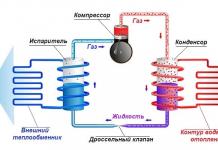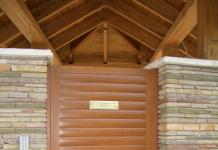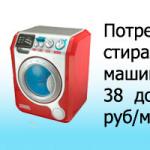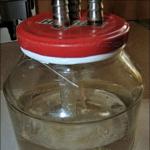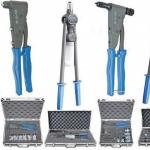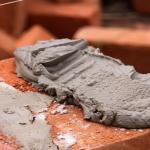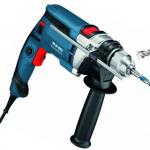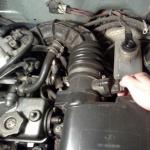A riveter is a special hand tool that is designed to connect materials using rivets.
Such a tool is considered simple, since it performs only one specific function - riveting.
A riveted joint is a non-separable bond of several materials, mainly sheets. The positive aspects of riveted joints are vibration resistance, reliability and ease of installation of joints. The rivet withstands a large load applied to the part. And if the connection does not withstand, it does not break immediately, and the rivet seems to stretch, which compares favorably with the welded connection.
Helpful information:
Principle of operation
The process of working with a riveter is very simple. It is necessary to drill through holes in the fastened materials. Approximately one tenth of a millimeter larger than the diameter of the rivet used. The riveter mechanism captures the rivet shank (wire) to the working part, after which the traction mechanism is actuated, which draws the rivet head to the base through the wire and breaks the wire (when the rivet joint is ready).
Riveters by type

- Mechanical
- Pneumatic
- Rechargeable (electric)
- Pneumohydraulic
When choosing a riveter, it is necessary to take into account such points as:
- The lightness and compactness of the tool (this increases the convenience of work)
- It is better to choose a model with a rotary working part (this will provide access to difficult places to work)
- The handles of the riveter must be equipped with rubber pads (this facilitates the work, as it prevents the hand from slipping on the handle of the tool during operation)
- The tool will be of better quality if its body is cast, and not from a metal plate
Mechanical riveters
The most common and popular type of riveters. They have the simplest device and are easy to use (do not require special skills).
Most models of riveters are equipped with a set of working heads for different rivet diameters.
Mechanical riveters come in different types:
One-Handed Riveters

They are designed for one-handed operation and are designed for a rivet that does not exceed a diameter of 4.9 mm. Some models of single-handed riveters are equipped with a swivel head that can be rotated 90, 180 and 360 degrees (which can make it easier to install the rivet in problem areas).
Two-handed riveters

They have a different design that allows you to develop more force, and suggest the possibility of working with rivets with a diameter of up to 6.5 mm.
Riveters "accordion"

They can put rivets in hard-to-reach places, while developing a sufficiently large effort when working with one hand.
Cordless riveters

In appearance, this tool is similar to a conventional screwdriver. The advantages of this type of riveters include the speed and quality of work, as well as a small application of forces during work. The downside is the limited operating time, it depends on the capacity of the battery.
Pneumatic riveters

They have greater productivity, compared to other types, due to the fact that they work from compressed air. The disadvantages of a pneumatic riveter include a complex device, limited mobility (depending on the size of the air supply hose) and heavy weight. The cost of such a riveter is quite high, but the performance is impressive.
Types of rivets
Before proceeding with the process of fastening parts using a riveted joint, one should take into account: what mechanical load this joint will carry, the location of the rivet and the thickness of the material to be fixed. All this affects the type of rivet that will be used.
There are currently many types of rivets, each with its own advantages.
Classical rivet

It is used for cold and hot riveting, has the form of a cylinder. Rivets of this type basically contain a solid metal rod, so they are best used in places that will experience heavy loads.
Semi-tubular and tubular, piston rivets

Such rivets are used in connections with a small load, since the rivets are hollow from the inside. They are made of soft metal and on one side, instead of a head, they have a stamped conical recess.
Mortgages, traction, blind, blind rivets

This is the easiest and most convenient type of rivet to use (it does not need to be held on the other side). Such rivets are of the following types:


Sealed rivet with gas-tight body (blind rivet)
Threaded rivets

The so-called rivet nut. It looks like a cylinder with a countersunk or wide flange, it is designed to securely connect thin parts.
In the manufacture of rivets, various metals and their alloys (aluminum, copper, steel, brass, etc.) are used, and rivet rods are made only of solid steel.
A very important factor when choosing a rivet is its length. If the length of the rivet is greater than the thickness of the materials being joined, then the rivet will close outside of the mounting hole (i.e. the joint will not be tight). When the length of the rivet is less than the thickness of the materials, the closing head of the rivet cannot be formed.
It is necessary to clearly understand all the features of the work to be done and the characteristics of the materials used in order to perform the proposed work with high quality and without excessive effort.
tweet
Pin it
Like
In the vast world of fasteners, steel rivets occupy a special place, invented much earlier than threaded and, even more so, welded joints, they still adequately fulfill their purpose in various spheres of human life.
In contact with
Alternative Fasteners
Their main task - to fasten metal (and not only) parts - products regularly perform and always guarantee the reliability of the resulting structure.
They are durable, easy to install and resistant to chemicals. At the same time, they are compact and versatile. Today they are trusted by masters of various fields: shipbuilding, aircraft building and car repair.
Rivets for plastic and metal are widely used in electrical engineering, in the manufacture of containers, and in the construction of bridges. Often used as an alternative, for example, in explosive and fire hazardous facilities. Only they can cope with fastening parts in places where access for other types of connections is limited.
Advantages and disadvantages
Why is this type of connection preferred, for an abundance of advantages or a minimum of disadvantages. Let's list those and others.
Advantages:
- compactness;
- durability;
- reliability;
- the ability to work with various materials;
- low price;
- variety in sizes and materials;
- possibility of color selection.

Compactness is undeniably convenient. The main rival of the products - a bolted connection with its own set of nuts and washers - is clearly not a priority.
Important! The service life of rivets, subject to the rules of installation and operation, can be equal to the service life of the parts themselves in the joint.
Products are practical not only when connecting metal parts. Today they are widely used when working with plastic and in textile production. They look original in combination with wood, leather. The aesthetic component of the priority of this fastener is the ability to choose a color solution. , varnishes or variants of electroplated coatings - this is already the taste of the consumer.
Prices for extruded aluminum rivets
pull-out aluminum rivets
Flaws:
- create an inseparable connection;
- installation of certain types takes a lot of time;
- the vast majority - disposable;
- installation requires special tools and experience.
 A riveted connection, by definition, does not provide for its disassembly. Installation of almost all types cannot be classified as fast. This applies to retro under a hammer, and to more modern threaded ones.
A riveted connection, by definition, does not provide for its disassembly. Installation of almost all types cannot be classified as fast. This applies to retro under a hammer, and to more modern threaded ones.
Each stage of establishing a connection (marking, and riveting itself) is labor-intensive, although this can be sacrificed in the struggle for the quality of the connection.
The metals that go into the production of rivets, no matter how soft, remain metals. In this regard, the installation of these fasteners requires the use of a specific tool: from a simple hammer and mandrel to a complex one, such as a riveter.
Types of fasteners
In nature, there are many types of fasteners and the same variety of fasteners.
We list the most popular of them:
- driven,
- exhaust threaded,
- exhaust smooth.
The classic and most ancient type of fasteners is a driven version. The second and no less popular name is “under the hammer”. The material can be very different: aluminum, copper, steel. They consist of a cylindrical rod and a head (for the most part, according to GOST 10299-80, this is a hemisphere). Heads in semi-hidden, sweat (GOST 10300-80) and cylindrical are also popular.

Important! The diameter of the rivets cannot be unlimited. Economic and technical feasibility determine their maximum length.
They are simple in form, simple auxiliary tools are used as installation assistants: a sedimenter, a pretensioner and a hammer. In mass production, steel products are mounted with electric hammers or piston hammers.
When riveting on weight, one cannot do without reinforcements (anvils). During installation, the driving rivet requires compliance with the tolerance standards for the hole diameter and the length of the rivet. Insufficient length will not allow the formation of an optimal head, excessive length will violate the tightness of the connection.
 The design consists of two bushings connected on its head. The outer sleeve should be longer than the inner sleeve and made of a softer metal. The difference in the length of the bushings must be at least half the diameter of the hole in the parts to be joined. A thread is cut in this area, due to which the outer sleeve will be crushed and a second head will be formed.
The design consists of two bushings connected on its head. The outer sleeve should be longer than the inner sleeve and made of a softer metal. The difference in the length of the bushings must be at least half the diameter of the hole in the parts to be joined. A thread is cut in this area, due to which the outer sleeve will be crushed and a second head will be formed.
Of all types of threaded rivets are the most expensive. However, the threaded rivet compensates for these shortcomings with quality, installation speed and a neat appearance. The latter argument justifies their widespread use in the automotive industry and in the manufacture of various household appliances. The largest blind rivet has an internal thread M16, the smallest - M2.
Exhaust smooth - the most popular type of connection of parts for lightly loaded structures. Widely used in everyday life, in private courtyards and in workshops. A worthy alternative to welding where available. The popularity of this type of fastener obliges to dwell on them in more detail.
Design features
 Classic blind rivets are a structure consisting of a cylindrical body with a head and a shank. During installation, the extension of the shank (core) contributes to the formation of a second head on the back side. Thus, there is a reliable fixation of the parts to each other.
Classic blind rivets are a structure consisting of a cylindrical body with a head and a shank. During installation, the extension of the shank (core) contributes to the formation of a second head on the back side. Thus, there is a reliable fixation of the parts to each other.
Head, body and shank diameters are regulated by the requirements of GOST 10299-80. The length of the shank is also normalized by the dimensions of the gripping mechanism of the riveter.
Modern types of blind rivets can be made from various materials.
Here is a list of the most popular body/shank combinations:
- Steel (galvanized) / steel (galvanized);
- Aluminium/steel (galvanized);
- Aluminum / aluminum;
- Aluminum / stainless steel;
- Stainless steel / steel (galvanized);
- Stainless steel / stainless steel;
- Copper / steel (galvanized);
- Copper / bronze;
- Plastic / plastic.
Ideally, pull rivets and fastened parts should be of the same metal. This will eliminate the formation of a galvanic process (accelerated destruction of a more active metal) and extend the life of the metals of the fastened parts and the fastener itself.
 The cylinder filling the hole can be either smooth or corrugated. Small protrusions here imply a collapse during installation (for example, from a light blow with a hammer) and thus allow a weak and tight fit.
The cylinder filling the hole can be either smooth or corrugated. Small protrusions here imply a collapse during installation (for example, from a light blow with a hammer) and thus allow a weak and tight fit.
The aforementioned State Standard 10299-80 strictly regulates all dimensions (geometry) of aluminum exhaust products. Such unification makes it possible to bring the use of these connections into the system and simplify the calculations of most prefabricated structures.
When length matters
We repeat, pointing out the importance of such a parameter as length. The correct formation of the closing head and the tightness of the connection depend on it. Excessive length here will be just as harmful as its lack. Against this background, the task of calculating the optimal length of the connecting elements is of great importance.
S is the total thickness of the connected parts;
d is the diameter;
L is the desired length.
Example: we have two parts with a thickness of 10 and 15 mm. The calculated diameter of the rivets is 4 mm. According to the formula: L \u003d S + 1.2d we have - 10 + 15 + 1.2 * 4 \u003d 26.8 mm.
In this formula, "1.2" is a correction factor.
 Its meaning depends on:
Its meaning depends on:
- head shapes;
- material;
- heat treatment.
For domestic use, the length of the rivets is calculated at a factor of 1.2. In this case, it can be taken as average and optimal.
Table 1 will help you choose the closest size for diameter 4. We get 30 mm.
The science of "Strength of Materials" recommends placing blind rivets (and not only) at a distance of no closer than five diameters from each other. We add that there are special formulas for calculating fasteners for shear and crushing of heads. Such calculations are made when designing rather important structures, and in everyday life they are practically not resorted to.
Installation
Consider the process of installing traction fasteners. There are two parts that need to be connected together. After simple calculations in terms of size and required quantity, selection of the nearest standard size, we carry out the process in a certain sequence.

Main stages:
- make a surface marking;
- we drill holes taking into account the allowance;
- remove possible burrs on both sides of the hole;
- we install exhaust aluminum products in the hole with the shank facing us;
- we make a capture with a riveter;
- tightly pressing the caliper of the riveter to the head, smoothly, but with force, squeeze the handles of the tool;
- the remaining free part of the shank is carefully cut off or broken off with wire cutters, the sawing option also has the right to exist here;
- if necessary, with a file, we give the head a neat finished look.
Despite their archaic origin, aluminum exhaust mounts continue to be very popular in our time. This applies equally to industry, construction, and domestic use.
Useful video: features of screw and blind rivets
A variety of sizes and materials contributes to their versatility, and the exact calculation of the geometry for each use is a guarantee of reliability and durability of this fastening. Do not neglect the calculations, because mistakes can subsequently bring not only loss of time and psychological discomfort, but also result in more serious consequences.
Blind rivets are a fairly common fastening material and are widely used in many areas of human activity. Details have replaced the outdated methods of riveting and have become firmly established in everyday life.
Purpose
Blind rivets are used to connect sheet material and require access to the working surface from one side only. This is one of their main differences from the traditional "hammer" models. Rivets are mounted in a drilled hole using a special tool, which can be either manual or pneumoelectric. The connections made with blind rivets are very strong and durable. In addition, the parts are easy to assemble and are highly resistant to aggressive chemicals, high temperatures and humidity.


Due to its versatility and reliability, the scope of blind rivets is quite extensive. Details are actively used in shipbuilding, aircraft and mechanical engineering, textile industry and construction. Rivets act as an alternative to welding joints when working at high-risk facilities. In addition, rivets are widely used in the repair of parts and mechanisms in hard-to-reach places and at fire hazardous objects. In addition to connecting elements made of ferrous and non-ferrous metals, blind rivets are able to connect plastic and textiles in any combination. This allows them to be widely used in electrical work and actively used in the manufacture of clothing, textile consumer goods and tanks.




Advantages and disadvantages
High consumer demand for blind rivets is due to a number of undeniable advantages of these hardware.
- Ease of installation due to the need to access the connection only from the front side. This favorably distinguishes these hardware from threaded nuts, for the installation of which access is required from both sides. In addition, threaded fasteners tend to loosen over time and loosen the connection.
- The low cost of blind rivets allows you to create a reliable and durable fastening without saving on material.


- A wide range of standard sizes greatly facilitates the choice of fasteners.
- The ability to connect materials of different structure and properties significantly expands the scope of hardware.
- High strength and durability of the connection. Subject to the installation rules and careful operation, the service life of rivets is equal, and sometimes exceeds the service life of the fastened parts.

The disadvantages include the need for pre-drilling, non-separable connection and the application of significant effort when riveting by hand. In addition, the models have a one-time purpose and cannot be reused.
Manufacturing materials
A wide variety of materials are used as raw materials for blind rivets. This allows the use of hardware in almost all types of repair and construction work. For the manufacture of rivets, a number of materials are used, each of which has its own strengths and weaknesses and determines the installation location of future products.


Aluminum
Often use its anodized or varnished modification. Aluminum rivets are lightweight and low cost, however, in terms of strength, they are somewhat inferior to steel models. Products are used for fastening light metals, plastic and are widely used in electrical engineering.
Stainless steel
Also used in several modifications. So, brand A-2 is considered one of the most resistant to rust and is used for mounting parts when performing outdoor work. Whereas A-4 has no equal in acid resistance and is widely used in chemical industries.




Cink Steel
Possesses high anticorrosive properties and provides reliable connection. However, if one of the connected elements has mobility, galvanized parts wear out quickly.
copper alloys
Widely used in the manufacture of rivets. The most popular is monel, an alloy consisting of 30% copper and 70% nickel. Sometimes bronze is used as a rod in copper models. The downside of copper elements is their high cost and the risk of green deposits during oxidation.




Polyamide
Used for the manufacture of rivets used in light industry and for tailoring. The material is not particularly durable, but it can be painted in any color and looks good on products.
Ideally, all elements of the rivet should be made of the same material. Otherwise, the risk of galvanic processes increases, during which a more active metal destroys a weaker one. The principle of compatibility must be guided by the selection of hardware for certain materials. For example, a combination of copper and aluminum is highly undesirable, despite the fact that copper behaves quite friendly with other metals.



Kinds
The type of hardware is selected in accordance with the requirements for the connection. Due to the fact that the modern market of fasteners presents a wide range of blind rivets, it will not be difficult to choose the right element. Depending on the performance characteristics, hardware is divided into several types.
- Combined models are considered the most common type. Hardware is capable of providing a one-piece connection of especially hard parts subjected to mechanical, weight and vibration loads.



- Sealed Models have a rather narrow specialization and are widely used in shipbuilding industries. A feature of the design of deaf models is the sealed end of the rod. Products can be made of stainless steel, copper and aluminum.
- Multi-clamp models have several riveting sections and are installed in mobile structures if it is necessary to connect three or more elements. Such a section is located between two adjacent elements, and installation is carried out using an air gun.




In addition to traditional models, there are reinforced versions of rivets, the manufacture of which uses a stronger material with thicker walls.
Typical dimensions
According to GOST 10299 80, the shape, dimensions and diameters of the heads and shanks of blind rivets are strictly regulated. This allows you to systematize the use of hardware, as well as simplify the calculation of the parameters of parts and accurately determine their number. The reliability and durability of the connection depends on how accurate the calculations are. One of the main parameters of rivets is their length, which can be calculated using the following formula: L=S+1.2d, where S is the sum of the thickness of the connected elements, d is the diameter of the rivet, and L is the required length of the hardware.



The rivet diameter is chosen 0.1-0.2 mm less than the drilled hole. This allows you to freely place the part in the hole, and by adjusting its location, rivet. Typical blind rivet diameters are 6, 6.4, 5, 4.8, 4, 3.2, 3 and 2.4 mm. The length of the rivets varies from 6 to 45 mm, which is quite enough for joining materials with a total thickness of 1.3 to 17.3 mm.
Design and principle of operation
Blind rivets are produced in strict accordance with the DIN7337 standard and are regulated by GOST R ICO 15973. Structurally, the parts include two elements: a body and a rod. The body consists of a head, a sleeve, a cylinder and is considered the main element of the rivet that performs the fastening function. For some hardware, the cylindrical base is sealed tightly. The head of the body can be equipped with a high, wide or hidden side.


The first two provide the most reliable connection, however, they will be clearly visible from the front side. The secret one does not have such high reliability indicators as high and wide, but is also widely used in construction and repair. This is due to the fact that the height of the head of the countersunk ledge does not exceed 1 mm, which makes the hardware almost invisible on the fastened surfaces. The rod (core) is an equally important part of the rivet and looks like a nail. On the upper part of the element there is a head and a latch with a separation zone located between them, along which the rod breaks off during installation.


Blind rivets are available in different sizes. The numerical value of the hardware marking means the diameter of the cylinder and its length. Therefore, its dimensions are decisive when choosing fasteners. Both values are indicated through the "x" sign, and in front of them it is written what alloy the cylinder is made of. So, marking AlMg 2.5 4x8 will indicate that the hardware is made of magnesium-aluminum alloy, the outer diameter of the cylinder is 4 mm, and the length is 8 mm. The rivet rod is made of steel and serves to rivet the connection; during installation, it is pulled out and broken off using a pneumatic riveter or pliers.



The rivet works quite simply: a hardware is inserted into a through hole previously drilled in both sheets. After that, the sponges of the pneumatic gun rest against the side of the rivet, clamp the rod and begin to pull it through the body. In this case, the rod head deforms the body and tightens the materials to be joined. At the moment the limit value of tightening is reached, the rod breaks and is removed. You can use the product immediately after installation.
Installation
Installation of blind rivets is so simple that it is not difficult even for beginners.

A prerequisite for installation is only the presence of a riveting tool and compliance with the sequence of work.
- The first step will be marking on the front side of the top of the parts to be joined. The distance between two adjacent rivets should not be less than five diameters of their heads.
- Reaming of holes should be carried out taking into account a small allowance.
- Deburring is done on both sides of each part. If access to the closed side is limited, deburring it can be neglected.


- The installation of the blind rivet must be carried out in such a way that the shank is located on the front side.
- The capture of the rod with a riveter and the work with an air gun must be carried out smoothly and with sufficient force at the same time.
- The remaining part of the rod, if necessary, is cut off or bitten off with wire cutters. In the case of an inaccurate break of the rod, it is allowed to process the head with a file.
Nowadays, for fixing two or more elements to be riveted, it is customary to use blind rivets, which quickly replaced traditional metal rivets due to ease of installation and excellent performance properties. Today, these devices are widely used in construction, shipbuilding and ship repair, mechanical engineering, in the arrangement of security equipment, in the textile industry and many other areas of human activity. The solution makes it possible to achieve the strongest connection, however, if the task is to fasten heavy-duty parts, then it is customary to use threaded products.
What materials are rivets made from?
 A variety of materials are used for the manufacture of blind rivets. This feature significantly expands the scope of their application, allowing the product to be used in almost all types of work. In addition, the rivet itself can be painted in any color, which is necessary for light industry (textile), where special emphasis is placed on the color of the fixing element.
A variety of materials are used for the manufacture of blind rivets. This feature significantly expands the scope of their application, allowing the product to be used in almost all types of work. In addition, the rivet itself can be painted in any color, which is necessary for light industry (textile), where special emphasis is placed on the color of the fixing element.
When choosing materials for the production of rivets, the material of the fastened part is taken into account, as well as the characteristics of the environment where the fastened structure will be used. In most cases, the following materials are used for such purposes:
- Aluminum. Supports the use of pure metal and its varieties: anodized or varnished.
- Cink Steel. It is characterized by increased strength and many other advantages.
- Stainless steel. A2 has the highest resistance to rust, and A4 is coated with a reliable anti-corrosion layer and is able to tolerate acidic environments. Most often it is used in the chemical industry. Imported analogues, such as DIN 7337, are also popular. Stainless steel is considered the most popular and common material with excellent performance properties and increased strength.
- Copper.
- Copper-nickel alloy (monel). It is 70% nickel and 30% copper.
- Polyamide. It cannot boast of too high strength, therefore it is most often used in the production of clothing items and textile products.
Regardless of the materials used for the production of rivets, they undergo special certification and are also confirmed by the GOST standard.
 If you are faced with the question of choosing a material for the manufacture of fasteners, you must take a responsible approach to the selection of materials for hardware with fastened parts, which is associated with a high risk of destruction of the fastener. In most cases, this is due to the appearance of a galvanic pair hardware - detail. If the ambient humidity is high enough, which can be explained by getting wet, the galvanic couple becomes a conductor of electric current, which contributes to the destruction of the fastener.
If you are faced with the question of choosing a material for the manufacture of fasteners, you must take a responsible approach to the selection of materials for hardware with fastened parts, which is associated with a high risk of destruction of the fastener. In most cases, this is due to the appearance of a galvanic pair hardware - detail. If the ambient humidity is high enough, which can be explained by getting wet, the galvanic couple becomes a conductor of electric current, which contributes to the destruction of the fastener.
 For example, the contact of aluminum with steel leads to very rapid oxidation, as well as the destruction of aluminum. For this reason, it is customary to use stainless steel rivets of domestic or foreign production for fastening steel parts. Steel rivets are very popular due to their strength properties. But steel galvanized solutions are not very popular. This is due to the fact that the zinc coating cannot boast of a long service life, so it wears out very quickly. The problem in a special way progresses when using moving elements.
For example, the contact of aluminum with steel leads to very rapid oxidation, as well as the destruction of aluminum. For this reason, it is customary to use stainless steel rivets of domestic or foreign production for fastening steel parts. Steel rivets are very popular due to their strength properties. But steel galvanized solutions are not very popular. This is due to the fact that the zinc coating cannot boast of a long service life, so it wears out very quickly. The problem in a special way progresses when using moving elements.
A universal hardware is a copper alloy fastener. The only "enemy" of copper is aluminum, while the rest of the metal blanks practically do not conflict with the metal.
Among the disadvantages of such solutions:
- High price.
- The appearance of an ugly color after the start of the oxidation process (after a certain period of time, a green coating appears, which is the remnants of oxidized copper). True, such formations do not affect the strength of the product in any way.
 The most versatile fastener is polyamide. Such a rivet reliably protects almost everything that can be imagined, although it is not particularly strong for it.
The most versatile fastener is polyamide. Such a rivet reliably protects almost everything that can be imagined, although it is not particularly strong for it.
If you need to order rivets, be sure to pay attention to the material from which it is made. specific model.
What are the design features of exhaust rivets
 Aluminum (all sizes are available on almost any website of the respective store) rivets have always been in high demand. True, due to their low strength, they are not recommended for fastening heavy structures and those products that constantly under heavy load or aggressive environmental influences.
Aluminum (all sizes are available on almost any website of the respective store) rivets have always been in high demand. True, due to their low strength, they are not recommended for fastening heavy structures and those products that constantly under heavy load or aggressive environmental influences.
It is no secret that the basic elements of exhaust hardware are the body and the rod. A body, bushing or cylinder is used as a body. It is this part that plays the role of the main fastener, which performs the supporting function. The body includes a "side" head, as well as a hollow cylinder. Sealed hardware has a tightly sealed end.
Based on the type of head, hardware is distinguished with:
- High side.
- Wide rim.
- Secret side.
 The wide and tall options provide the strongest riveted fastening possible. Such fixing elements are visible from the side and are able to form characteristic "bulges" on the surface of the workpiece. As for the hidden side, it can provide an almost smooth surface at the attachment point, though reliability is significantly reduced. The thickness of the hidden side is about 1 mm, and the main massive part of the head is fixed in the mounting hole.
The wide and tall options provide the strongest riveted fastening possible. Such fixing elements are visible from the side and are able to form characteristic "bulges" on the surface of the workpiece. As for the hidden side, it can provide an almost smooth surface at the attachment point, though reliability is significantly reduced. The thickness of the hidden side is about 1 mm, and the main massive part of the head is fixed in the mounting hole.
The thickness and length of the rivet cylinder is different. It is the outer diameter of the cylinder that determines the diameter of the hardware in the order name. The dimensions of the cylinder play a very large role among all other dimensions. It is on them that you should pay special attention when buying these fasteners.
The main purpose of fastening is to provide a movable or fixed connection of several parts or elements.
In most cases, the dimensions of the cylinder are indicated by two numbers with a separating sign "X", where the first indicator determines the outer diameter, and the second - the length.
The rod is an important structural unit
The next, very important structural element of the blind rivet is the rod. It acts as a rivet and can be made of strong steel, which is much stronger than the body. The end of the rod has a special head, which acts as a riveting of the inserted end. When performing installation work, the rod is pulled out using a special pneumatic riveter, and if there are too many fasteners, you can get by with ordinary pliers. True, the latter case involves the use of a certain physical force.
The main advantage of the blind rivet design is the possibility of one-sided installation, when access to the fastener is sufficient from one side only.
A more durable solution (threaded) has a characteristic thread inside the cylinder.  There is no such thread in the classic blind rivet.
There is no such thread in the classic blind rivet.
The threaded cylinder also has a screwed-in rod, which is not pulled out with force, but is gently unscrewed. To strengthen the connection, a reliable screw or bolt is placed inside. As a result, it is possible to create a kind of "closed" fastener, which is often called deaf.
After determining the appropriate dimensions and materials, as well as choosing the appropriate type of flange, you can begin to search for a specific type of rivet itself.
What rivets are available on the market
Depending on the required characteristics that must be present in the fastener, the type of fastener is selected. Currently, several types of hardware are offered for sale:
- Combined. Able to provide reliable one-piece connections of structures made of hard alloys or materials with increased strength. In addition, they are also used for fastening thin-sheet materials. Today, combined rivets are a very popular type of fasteners, so they are often used for all kinds of installation work. The product provides the most durable fastening, which seamlessly copes with even the most intense loads.
- Sealed rivets. Such a solution is a highly specialized version of fasteners, which is especially in demand for the shipbuilding industry. The design feature of such fasteners is represented by a soldered end with a rod. Most often, such hardware is made of copper, however, for the arrangement of civilian ships and boats, you can get by with aluminum rivets. As for fasteners in industrial production, stainless steel models remain relevant there.
- Multi-clamp. Such products differ from all previous ones by the presence of several riveting sections. They can be used to fasten three or more structural elements for a movable connection. Between each two elements there is a riveted section. They are mounted using a special device (in most cases with a blind rivet gun).
- In addition, there are also reinforced models of hardware on sale. In fact, this is the same blind rivet, although its cylinder is made of a thicker material. In its quality it is customary to use durable aluminum.
Today there are many other types of fasteners that may differ in both the length and the shape of the rod, but there is no point in dwelling on them, since the above solutions are quite universal and quite suitable for most purposes.
Features of installing rivets
After acquiring a rivet, many people have a question: “How to install this fastener correctly?” Fortunately, the design of the product remains very simple and clear, so at the installation stage, any difficulties and incomprehensible moments are practically absent.
It is only important to acquire a special riveting tool, which will significantly reduce time costs and simplify the task ahead. Nowadays, such tools are available at any building materials hypermarket, so buying them will not be something very complicated. In addition, both mechanical riveters and pneumatic riveters are on sale. You can also use the electric model. If there is no opportunity to buy a tool, you can stop at ordinary pliers.
The installation process itself is carried out in the following way. Using a drill, it is required to drill a hole at the attachment point with a diameter of 0.1 millimeters less than the diameter of the attachment connection. The depth of the hole is comparable to the length of the cylinder, minus the length of the riveting section. A fastener is fixed into the hole with a rod towards itself, and then the rod is pulled out using a riveting tool. Ultimately, all elements are securely fixed.
Summing up
Exhaust type rivets are really a very useful, reliable and high-quality connecting element, with which you can carry out a lot of installation work, achieving the most durable and good connection of various structures. Modern rivets meet all requirements and standards, so they prevent product deformation even under the most intense impacts. When choosing such a solution, it is important to correctly prioritize and give preference to only proven products. This will allow you to make a reasonable purchase and avoid mistakes.
The oldest and most reliable method of joining sheet material with rivets is still used in the most critical metal joints. A properly selected rivet can withstand the load no worse than a welded joint. For vibrations or alternating loads, rivets have not yet come up with anything better.
Types of rivets
There are not as many varieties of rivets as it might seem at first glance:
- A simple general-purpose rivet according to GOST 10299 80. They are easy to distinguish by their mushroom shape, also called a closing head system. Such a rivet is characterized by high strength and durability under any load;
- A pull rivet is used to "seam" two sheets of metal in cases where access to the sheets to be joined is possible only from one side. Parameters and description are determined by GOST 15973-2005;
- Threaded rivets are considered to be the most technologically advanced, they are more convenient to use and allow you to create a collapsible connection, DIN 7338.
Important ! Materials for riveted joints must have a certain plasticity and toughness, therefore, low-carbon steel, copper, and aluminum wrought alloys are used for their manufacture.
Application of rivets
The choice of specific parameters and types of fasteners is determined by three main criteria:
- Ensuring the necessary strength of the connection, taking into account additional parameters and requirements for the seam;
- Technological capabilities of equipment for working with a specific type of riveted joint;
- Economic feasibility of using a riveted joint;
Threaded rivet nuts
The connection method using threaded rivets today can be called the most versatile. The basic idea behind the connection is the ingenious idea of fixing the body of the rivet in the riveting hole. For these purposes, a riveter for threaded rivets is used. The threaded structure itself is a hollow sleeve with an internal thread.

When making the connection, this sleeve is inserted into the drilled hole and aligned so that the parts to be joined fit snugly together. After that, the riveter rod is screwed into the threaded hole inside the workpiece. The front wall of the sleeve is fixed by the supporting surface of the tool, preventing the rivet from coming out of the hole. To rivet the sleeve, the riveter rod moves with great force towards the bearing surface. At the same time, the sleeve is crushed and precipitated, thereby forming a strong fixed connection.

The riveter rod is freely turned out of the bushing body. The most commonly used rivets are aluminum, brass or copper. The use of the latter is limited by high cost, so they are installed in cases where it is necessary to ensure good electrical contact between the surfaces to be joined.

The advantages of a threaded rivet connection include its "low trauma". During the operation of the riveter rod, the metal to be joined does not experience large loads or deformations. It is easy to connect a thin-walled metal or a profile of a complex configuration with a threaded bushing. Such fasteners are widely used in the assembly of household appliances, in the connection of individual units of car cladding, in the manufacture of various kinds of structures from corrugated board.

Blind rivets
The disadvantage of threaded types of riveting is their high cost and relatively low speed of making connections. Therefore, for cases when the sheets of metal to be joined, the profile needs to be connected using several hundreds or thousands of points, an exhaust type of rivet is used.

These can be steel, brass hardware, rivets made of aluminum, aluminum and silicon alloys. Unlike threaded, in the exhaust scheme, the deformation of the sleeve is carried out using a rod with a thickening at the end, pressed into the body of the mounting sleeve. As in the previous case, in order to upset the body of the rivet, its end face rests against the supporting surface of the riveter, after alignment, the central rod is pulled out with force by several millimeters. As a result, the walls of the sleeve are deformed, forming a sufficiently strong one-piece connection. The shank of the rod most often breaks off or is cut off at the level of the cut of the sleeve.


For your information ! The exhaust scheme provides a very good metal riveting speed.
Classic rivet design
Steel rivets, standardized by the requirements of the Soviet GOST 10299 80, are considered the main hardware for riveting sheets in mechanical engineering. They most often connect highly loaded steel structures used in the construction business. For example, in frames and support assemblies. The advantage of the classical form is the possibility of connecting two sheet surfaces with a thickness of more than 30 mm.

In some cases, GOST 10299 80 allows assembly connections up to 35 mm. Unlike previous types of rivets, a classic rivet is installed only if there is a supporting surface on the back side of the joint plane. This is necessary to compensate for the shock load on the rivet shank.
The riveting technology is performed in the following order:
- The line along which the installation of the rivet joint will be carried out is marked with dots for drilling holes in the metal to be joined.
- Sheets of metal are fixed using mechanical devices such as clamps or even spot welding. The extreme points of fastener installation are drilled, into which centering metal pins are inserted. In this case, the diameter of the holes is chosen in accordance with the recommendations of GOST 10299 80 by approximately 10% more than the diameter of the shank body.
- A hardware is inserted into the drilled hole so that the head is on the reverse side of the surface to be joined. The length of the fastener is also selected in accordance with GOST 10299 80. This will ensure the formation of a second head from a shank of normal dimensions after it has been riveted with a hammer or an electric striker.
For your information! Dimensions selected in accordance with GOST 10299 80 provide maximum strength of the connection.

When choosing a rod thinner in diameter, its strength may not be enough for a rigid connection. In this case, the shearing force in the radial direction is able to break off in turn most of the connections. After riveting, the fastener metal should completely fill the holes with a slight interference fit.
Do not neglect the recommendations of GOST 10299 80 when choosing the length of the fastener shank. A shank that is too long will prevent correct deformation and settling of the metal. Too short will not provide the formation of a second head of the required size and strength.
To increase plasticity, rivets made of certain steel grades can be heated to a high temperature before installation with forging of heads and hardening of fasteners. Aluminum, copper, brass rivets before installation can be treated with special liquids that prevent the development of electrochemical corrosion.
Conclusion
Despite the significant complexity of installation and some archaism of riveted fasteners, riveted fasteners are still widely used in the structures of aircraft, ships, and railway bridges. Therefore, in the next 20-30 years, the nature and method of using riveted joints will most likely not change.
